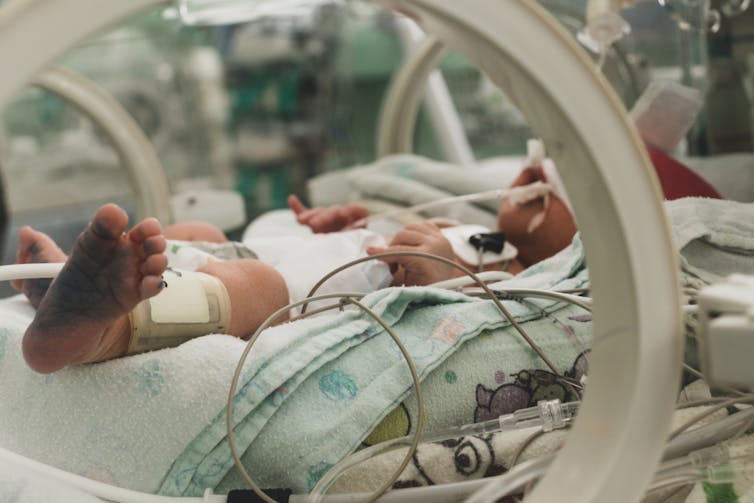Abortions on Babies That Can Live Outside of the Womb
This is one of our occasional Essays on Health. It's a long read. Bask!
The idea of growing babies outside the body has inspired novels and movies for decades.
Now, research groups around the globe are exploring the possibility of bogus gestation. For instance, one grouping successfully grew a lamb in an artificial womb for four weeks. Australian researchers take also experimented with artificial gestation for lambs and sharks.
And in contempo weeks, researchers in The Netherlands have received €2.9m (A$four.66m) to develop a prototype for gestating premature babies.
And so it'south important to consider some of the upstanding problems this engineering might bring.
Baca juga: From frozen ovaries to lab-grown babies: the future of childbirth
What is an artificial womb?
Growing a baby outside the womb is known equally ectogenesis (or exogenesis). And we're already using a form of information technology. When premature infants are transferred to humidicribs to continue their development in a neonatal unit of measurement, that'south partial ectogenesis.

But an bogus womb could extend the catamenia a fetus could be gestated exterior the body. Somewhen we might be able to do away with man wombs altogether.
This may audio far-fetched, but many scientists working in reproductive biotechnology believe that with the necessary scientific and legal support, total ectogenesis is a existent possibility for the future.
What would an artificial womb contain?
An bogus womb would demand an outer shell or chamber. That'south somewhere to implant the embryo and protect information technology every bit it grows. So far, beast experiments have used acrylic tanks, plastics bags and uterine tissues removed from an organism and artificially kept live.
An artificial womb would also need a synthetic replacement for amniotic fluid, a daze cushion in the womb during natural pregnancy.
Finally, there would have to be a style to exchange oxygen and nutrients (so oxygen and nutrients in and carbon dioxide and waste products out). In other words, researchers would have to build an artificial placenta.
Brute experiments accept used complex catheter and pump systems. Only there are plans to use a mini version of extracorporeal membrane oxygenation, a technique that allows blood to be oxygenated outside the torso.
Baca juga: The concern of IVF: how human eggs went from simple cells to a valuable commodity
In one case these are in place, artificial gestation could one day get as mutual every bit IVF is today, a technique considered revolutionary a few decades ago.
And just every bit in the example of IVF, there are many who are concerned about what this new realm of reproductive medicine might mean for the hereafter of creating a family unit.
So what are some of the ethical considerations?
Artificial wombs could help premature babies
The main word near bogus wombs has focused on their potential benefit in increasing the survival rate of extremely premature babies.
Currently, those born before than 22 weeks gestation have piddling-to-no promise of survival. And those born at 23 weeks are likely to endure a range of disabilities.
Using a sealed "biobag", which mimics the maternal womb might aid extremely premature babies survive and better their quality of life.
A biobag provides oxygen, a type of substitute amniotic fluid, umbilical string access and all necessary water and nutrients (and medicine, if required). This could potentially allow the gestational menstruation to exist prolonged outside the womb until the baby has adult sufficiently to live independently and with good health prospects.
An bogus womb might provide an optimum environment for the fetus to grow, providing information technology with the appropriate balance of hormones and nutrients. It would likewise avert exposing the growing fetus to external harms such as infectious diseases.
The technology might besides make it easier to perform surgery on the fetus if needed.
And information technology could run across the cease of long-term hospital stays for premature infants, saving health care dollars in the process. This is particularly noteworthy considering some of the largest private insurance payments are currently for neonatal intensive intendance unit expenses.
Artificial wombs could help with infertility and fertility
This emerging reproductive engineering may permit women who are infertile, either due to physiological or social reasons, with the chance of having a child. It may also offering opportunities for transgender women and other women born without a uterus, or those who have lost their uterus due to cancer, injury or medical atmospheric condition, to have children.
Similarly, information technology could allow single men and gay male couples to become parents without needing a surrogate.

Volition this lead to a broader discussion about gender roles and equality in reproduction? Volition it remove potential risks and expectations of pregnancy and childbirth currently only affecting women? Will this eliminate commercial surrogacy?
Equally, artificial wombs could aid fertile women who for health or personal reasons cull not to exist pregnant. It would permit those whose career choices, medication or lifestyle might otherwise betrayal a developing fetus to malformation or abnormality.
Artificial wombs may harm women, reinforce inequality and lead to bigotry
The prospect of bogus wombs might offer hope for many, just it also highlights a number of potential hazards.
For some women, using an bogus womb for gestation to continue might seem like a welcome culling to terminating a pregnancy. Simply there are fears that other women thinking well-nigh an abortion might be compelled to use an artificial womb to continue gestation.
Whether artificial wombs should be allowed to influence a adult female's right to choose is already under argue.
Baca juga: What'due south Mother's Twenty-four hours if yous've been born in a machine and raised by robots?
Bogus wombs might too further increase the gap between rich and poor. Wealthy prospective parents may opt to pay for bogus wombs, while poorer people volition rely on women's bodies to gestate their babies. Existing disparities in nutrition and exposure to pathogens betwixt pregnancies across socio-economic divides could likewise be exacerbated.

This raises issues of distribution of access. Will artificial wombs receive authorities funding? If it does, who should determine who gets subsidised access? Volition there be a threshold to run into?
Other issues concern potential bigotry individuals born via an artificial womb may face. How do we preclude discrimination or invasive publicity and ensure individuals' origin stories are not subject to negative public marvel or ridicule?
Others might consider artificial wombs to be securely repugnant and fundamentally confronting the natural reproductive lodge.
Preparing for time to come wombs
Currently, in that location is no prototype of an artificial womb for humans. And the engineering is very much in its infancy. Yet we do need to consider upstanding and legal problems before rushing headlong into this reproductive engineering.
Not only exercise nosotros need to ensure the engineering is prophylactic and works, we demand to consider whether it's the right path to take for different circumstances.
It might be easier to defend using artificial wombs in emergency situations, such as saving the lives of extremely premature neonates. However, using them in other circumstances might need broader social and policy considerations.
Baca juga: We must develop 'techno-wisdom' to forestall technology from consuming us
Without showtime establishing articulate regulatory and ethico-legal frameworks, the development and release of artificial wombs could be problematic. Nosotros need to clearly outline pregnancy termination rights, parenthood and guardianship issues, limitations to experimentation, and other issues before the technology is fully realised and bachelor. Nosotros demand to do this soon rather than assuasive the law to lag backside the science.
We recommend:
-
approved protocols for testing artificial wombs that gradually extend the gestation period
-
funding that prevents discrimination on socio-economic grounds. This might exist in the form of regime funding to ensue a wide range of groups accept access to the technology
-
articulate legal guidelines for the status of ectogenetic embryos and fetuses, including what happens if prospective parents die, divorce or disagree on how to proceed
-
guidelines for access that calm public fears about misuse of emerging reproductive technologies.
It is easy to get carried away with visions of utopian or dystopian societies. Every bit radical and futuristic equally bogus wombs might sound, it is important to interruption and reflect on the present.
While this technology may solve some existing issues apropos inequality in reproduction, there are many other problems that need our firsthand attention.
Improving maternal wellness services, equal opportunity in the workplace, and reducing the impact of poor social determinants of wellness on fetal outcomes are all pressing concerns nosotros must address now before we can consider what the future of reproductive biotechnology might agree.
Baca juga: Where we come from determines how we fare – the fetal origins of developed disease
masseywortatuslege.blogspot.com
Source: https://theconversation.com/we-may-one-day-grow-babies-outside-the-womb-but-there-are-many-things-to-consider-first-125709
0 Response to "Abortions on Babies That Can Live Outside of the Womb"
Publicar un comentario